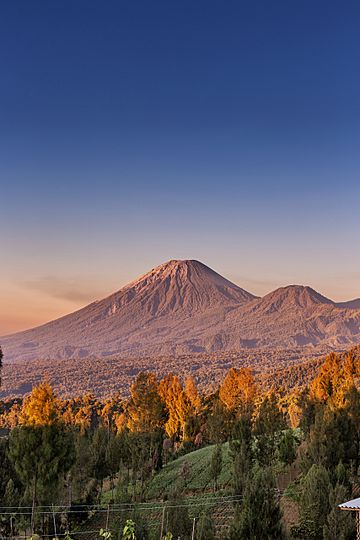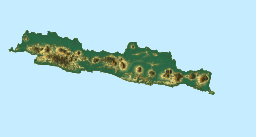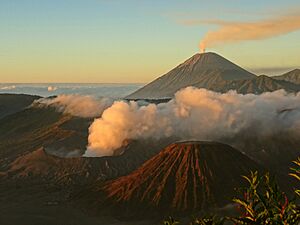Semeru facts for kids
Quick facts for kids Semeru |
|
|---|---|
| (Javanese: ꦱꦼꦩꦺꦫꦸ, romanized: sěmèru) | |
 |
|
| Highest point | |
| Elevation | 3,676 m (12,060 ft) |
| Listing | Island high point 12th Ultra Ribu |
| Geography | |
| Headwaters of river basins | Mujur, Rejali, Glidik & Brantas basin |
| Geology | |
| Mountain type | Stratovolcano |
| Volcanic arc | Sunda Arc |
| Last eruption | Ongoing |
| Climbing | |
| First ascent | Unknown |
| Easiest route | Hike |
Semeru is the tallest mountain on the Indonesian island of Java. It is an active volcano located in the province of East Java. Semeru stands 3,676 meters (about 12,060 feet) tall. This makes it the third tallest volcano in Indonesia. It sits in a special area where two huge pieces of Earth's crust, called tectonic plates, are pushing against each other. The Indo-Australian Plate is sliding under the Eurasian Plate here.
The name "Semeru" comes from "Meru" or "Sumeru." In Hinduism, Meru is believed to be the central mountain of the world and home to many gods. Semeru is a type of volcano called a stratovolcano, which means it's built up by many layers of hardened lava, ash, and rock. It is also known as Mahameru, which means "The Great Mountain" in an ancient language called Sanskrit.
Contents
What is Semeru's Geology?
Semeru rises steeply from the flat coastal areas of eastern Java. Along the top of the volcano, you can find small, bowl-shaped craters called Maars. Some of these maars hold beautiful crater lakes. Semeru formed south of two older, larger collapsed volcanic craters known as calderas, called Ajek-ajek and Jambangan. The rocks and ash that erupt from Semeru are mostly a type called andesitic. Semeru is part of a larger group of volcanoes known as the Tengger Volcanic Complex.
Semeru's Eruptions Over Time
Semeru has a long history of eruptions. Since the year 1818, there have been at least 61 times when the volcano erupted. These eruptions included flows of hot lava and fast-moving clouds of gas and rock called pyroclastic flows. Sadly, 11 of these eruptions caused people to lose their lives. Most of Semeru's eruptions have been of a medium size, rated as a 2 or 3 on the Volcanic Explosivity Index (VEI). Semeru has been very active since 1967. Its most recent eruption happened in November 2025.
The 2021 Eruption
In 2021, Semeru erupted several times, including in January and again on December 4th and 6th. During these eruptions, the volcano shot ash and other materials up to 11 kilometers (about 7 miles) high. Lava flowed for distances between 5 and 11.5 kilometers (3 to 7 miles). Ash also rained down over areas as far as 30 kilometers (19 miles) away. These events had a big impact. At least 57 people lost their lives, and 104 others were injured. 23 people were reported missing. More than 10,000 people had to leave their homes. The eruption also damaged 1,027 houses, 43 public buildings, and two bridges.
The 2022 Eruption
Heavy monsoon rains in 2022 and 2023 caused the top part of the volcano, called a lava dome, to collapse. This led to another eruption on December 4, 2022. This eruption sent a pyroclastic flow traveling 12 kilometers (about 7.5 miles). It also caused a special type of earthquake linked to the pyroclastic flow, and 13 other earthquakes caused by the eruption itself.
The 2025 Eruption
On November 19, 2025, Semeru erupted again. A pyroclastic flow rushed down the southern side of the mountain, reaching 7 kilometers (about 4.3 miles). An ash cloud rose 2 kilometers (about 1.2 miles) into the sky. By November 20, 2025, three people were injured, and 1,116 people had to move to safer places. The eruption also damaged 21 houses and one school building.
Legends of Semeru
The name Semeru comes from Sumeru, a very important mountain in Hinduism. According to an old legend, Sumeru was brought from India to create the island of Java. This story is written in a 15th-century book from East Java called Tantu Pagelaran. The legend says that the mountain was first placed in the western part of Java. But this made the island tip over! So, the gods decided to move it eastward. As they carried it, pieces of the mountain broke off. These pieces formed other mountains like Lawu, Wilis, Kelud, Kawi, and Arjuno and Welirang. The journey also caused the base of Semeru to shake, and its very top broke off, creating another mountain called Penanggungan. Many Indonesian Hindus believe that Mount Semeru is where the god Shiva lives on Java.
Environmental Challenges for Semeru's Plants
Mount Semeru National Park faces some challenges that affect its plant life.
Non-Native Invasive Plants
Scientists have found 25 types of plants in Mount Semeru National Park that are not originally from the area. These "non-native" plants can be harmful because they compete with the unique "endemic" plants that naturally grow there. Many of these plants were brought in during the colonial era, a long time ago. For example, around 1906-1907, a Dutch plant park owner named M. Buysman collected many foreign plants. These plants later spread from his park into the surrounding areas. Some examples of these non-native plants include Foeniculum vulgare, Verbena brasiliensis, Chromolaena odorata, and Salvinia molesta.
Impact of Vegetable Farms
Mud from nearby vegetable farms is washing into Ranu Pani Lake. This mud adds "silt" (fine dirt) to the lake, causing it to slowly get smaller. Experts had concerns that the lake might disappear by around 2025. To help save the lake, farmers could replace the vegetable farms on the hillsides with "perennials" – plants that live for many years and help hold the soil in place.
See also
 In Spanish: Semeru para niños
In Spanish: Semeru para niños
- List of volcanoes in Indonesia
- List of Southeast Asian mountains
- List of islands by highest point
- Volcanological Survey of Indonesia
- Lists of volcanoes
- Argo Semeru





